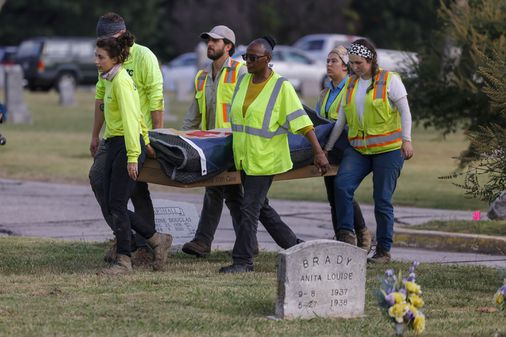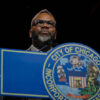
More than a century after one of the worst incidents of racial violence in US history left scores of Black people dead in Tulsa, the mayor announced Thursday that the city would form a commission to study how reparations could be made to survivors and their descendants.
The announcement was followed Friday by news that an Oklahoma archaeology team had exhumed another set of human remains with a gunshot wound — a haunting reminder of the mob violence that ripped through 35 square blocks of what was once a wealthy Black community. The remains were the third set with a gunshot wound discovered since scientists began excavating a cemetery in 2020 to try to identify the Tulsa Race Massacre’s victims.
The developments come after decades of debate over how — if at all — reparations should be doled out to victims and their families for the violence that has limited the economic advancement of generations of Black Tulsans. During the 1921 massacre, a white mob destroyed Greenwood, an all-Black community nicknamed Black Wall Street, leaving as many as 300 Black people dead and 10,000 homeless.
“Our fellow Tulsans were murdered, their homes and businesses torched, their bodies buried in unmarked graves so their loved ones couldn’t find them,” Tulsa Mayor G.T. Bynum (R) said at a news conference Thursday. “And to this day, no one has ever been held to account for it. To call it an outrage does not do it justice.”
The committee’s creation was prompted by a 2023 report by the city that recommended more than a half-dozen types of reparations. Descendants of victims and Tulsa residents said educational opportunities — scholarships and tuition assistance — and direct cash payments were the most crucial reparations, according to the report.
The 13-member committee, called the Beyond Apology Commission, will forge a plan for a housing equity program that is meant to benefit massacre survivors, their descendants and residents of North Tulsa, particularly the Greenwood District and surrounding neighborhoods. Bynum, who will select the committee members, has previously demurred on the idea of financial reparations.
In 2020, he told Tulsa-based TV station KTUL that distributing cash payments “divides the community on something that we really need to be united around.” Debate over compensation led to the cancellation of an event commemorating the bloodshed the next year.
On Thursday, Bynum said he wants the committee to explore types of reparations beyond cash payments.
“We’re not just establishing a study group,” he said at the news conference, adding that he wants city funds to promote homeownership “and advance the goal of creating intergenerational wealth” among the massacre’s descendants.
The Washington Post could not reach Bynum for comment Sunday.
Other states and cities have created groups to decide on reparations for Black residents, including Boston, D.C., and Chicago. A task force established by the California state legislature recommended billions in reparations last year, and lawmakers set aside $12 million in their next budget to provide recompense to Black residents.
In an effort to learn how Tulsa Race Massacre victims died and whether they’re related to current residents, Bynum announced in 2018 that the city would reopen an investigation into possible mass graves related to the violence. The project has since helped uncover dozens of remains and tombstones in Tulsa’s Oaklawn Cemetery, blocks from Greenwood. In July, scientists identified a victim of the massacre for the first time since 2001.
State archaeologist Kary Stackelbeck said in a video message Friday that scientists recently discovered 40 graves in new parts of the cemetery. Three sets of remains have been found, she said, including one with a gunshot wound. They were exhumed and sent to a forensic lab to be analyzed, Stackelbeck said.
“Excavation is continuing, and so we will expect that’s going to go into this next week,” she said in the video.
The last two known survivors of the Tulsa Race Massacre attempted to receive reparations through a lawsuit, claiming that the city, county, Oklahoma National Guard, and other officials caused a “public nuisance” by failing to defend the Black community in 1921. But the Supreme Court of Oklahoma dismissed their case in June, writing that the harm the massacre has caused survivors doesn’t fall within the scope of the state’s “public nuisance” law.
Vanessa Hall-Harper, a Tulsa city councilor, said in a statement Thursday that Tulsa’s creation of a reparations committee alone “does not absolve the city of the wrongs that followed the 1921 Tulsa Race Massacre.”
“I hope this new Commission will work toward establishing and implementing a reparations program that goes beyond merely apologizing for the atrocity that continues to haunt this city,” she said.


